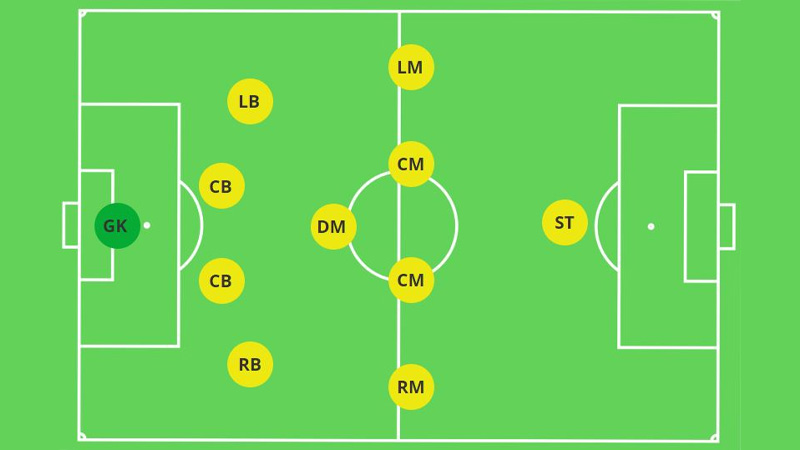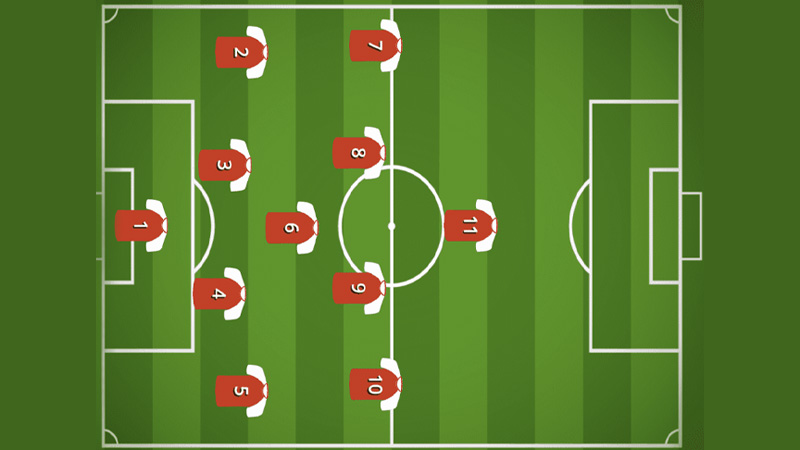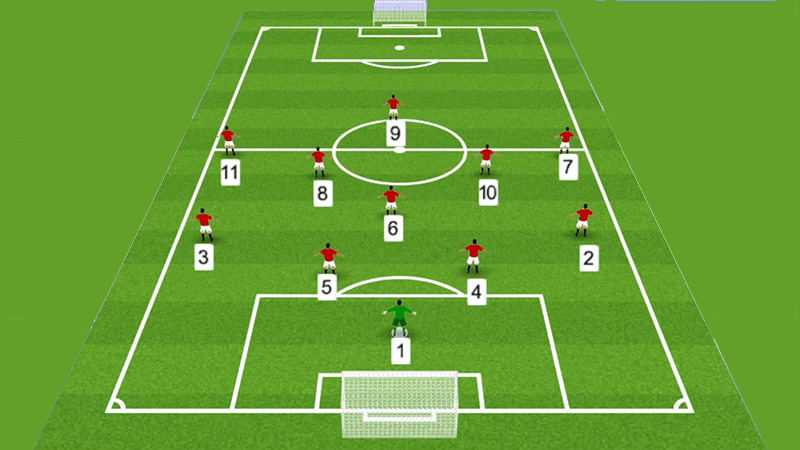In the ever-evolving world of soccer tactics, coaches and players are constantly seeking innovative strategies to gain an edge over their opponents. One such formation that has gained significant popularity in recent years is the 4-1-4-1 formation.
The 4-1-4-1 formation is characterized by a strong defensive structure, with four defenders forming a solid backline, supported by a defensive midfielder who acts as a shield in front of the defense.
It allows teams to maintain numerical superiority in midfield, control possession, and create scoring opportunities.
However, mastering the 4-1-4-1 formation requires a deep understanding of positional responsibilities, effective communication, and cohesive teamwork.
In this tactical guide, we will delve into the intricacies of the soccer 4-1-4-1 formation, exploring its key principles, player roles, and strategies to maximize its potential on the field.
What Is the 4-1-4-1 Soccer Formation?
The 4-1-4-1 soccer formation is a tactical setup that consists of four defenders, one defensive midfielder, four midfielders, and one lone striker. It is a variation of the 4-4-2 formation, but with a more compact and defensive approach.
In this formation, the four defenders typically form a solid backline, with two central defenders and two full-backs providing defensive cover.
The defensive midfielder, often referred to as the “holding midfielder,” sits in front of the defense, acting as a shield and providing support in both defensive and offensive phases of play.
The four midfielders are deployed in a flat line, with two central midfielders and two wide midfielders. The central midfielders have a dual role of supporting both defense and attack, while the wide midfielders provide width and contribute to both defensive and offensive duties.
Upfront, there is a lone striker who leads the line and is responsible for creating goal-scoring opportunities and finishing chances.
The 4-1-4-1 formation offers a balanced approach, with a strong defensive structure and the ability to quickly transition from defense to attack. It allows teams to maintain numerical superiority in midfield, control possession, and create scoring opportunities.
How Do You Play a 4-1-4-1?

Source: themastermindsite
Playing a 4-1-4-1 formation effectively requires a clear understanding of positional responsibilities, effective communication, and cohesive teamwork. Here are some key aspects to consider when playing in a 4-1-4-1 formation:
Defensive Shape
The four defenders should maintain a compact and organized backline, communicating and coordinating to deny space for the opposition. The defensive midfielder acts as a shield in front of the defense, providing cover and intercepting passes.
Midfield Balance
The central midfielders should work in tandem, with one player focusing more on defensive duties and the other contributing to both defense and attack. The wide midfielders should provide width, stretching the opposition’s defense and supporting both defensive and offensive phases.
Transition Play
Quick transitions from defense to attack are crucial in the 4-1-4-1 formation. The defensive midfielder plays a pivotal role in initiating counter-attacks by distributing the ball efficiently to the midfielders or the lone striker.
Support for the Lone Striker
The lone striker should be supported by the midfielders, who should make forward runs, provide through balls, and create scoring opportunities. The striker should hold up the ball, bring others into play, and be clinical in finishing chances.
Communication and Teamwork
Effective communication and understanding between players are vital in any formation. Players should constantly communicate, provide support, and maintain positional discipline to ensure the formation functions cohesively.
Flexibility and Adaptation
The 4-1-4-1 formation can be adjusted based on the team’s strengths, weaknesses, and the specific challenges posed by the opposition. Coaches and players should be willing to adapt strategies and make tactical changes as needed.
By implementing these principles, teams can effectively play the 4-1-4-1 formation, maintaining defensive solidity, dominating the midfield, and creating scoring opportunities. Practice, tactical awareness, and a commitment to teamwork are key to mastering this formation.
What Are the Strengths of the 4-1-4-1 Formation?

Source: soccerprime
The 4-1-4-1 formation offers several strengths that can benefit a team on the soccer field. Here are some key strengths of the 4-1-4-1 formation:
Defensive Solidity
With four defenders and a dedicated defensive midfielder, the 4-1-4-1 formation provides a strong defensive structure. The compactness and numerical superiority in midfield make it difficult for the opposition to penetrate and create scoring opportunities.
Control of the Midfield
The 4-1-4-1 formation allows teams to dominate the midfield. With four midfielders, including a defensive midfielder, teams can maintain numerical superiority in this crucial area of the pitch.
This control of the midfield enables teams to control possession, dictate the tempo of the game, and limit the opposition’s attacking opportunities.
Quick Transition from Defense to Attack
The 4-1-4-1 formation facilitates quick transitions from defense to attack. The defensive midfielder acts as a pivot, initiating counter-attacks by distributing the ball efficiently to the midfielders or the lone striker. This quick transition can catch the opposition off guard and create scoring opportunities.
Flexibility and Adaptability
The 4-1-4-1 formation offers flexibility and adaptability based on the team’s strengths and the specific challenges posed by the opposition. It can be adjusted to suit different styles of play, allowing teams to be versatile in their approach.
Balanced Attack
The 4-1-4-1 formation provides a balanced approach to attacking play. The lone striker is supported by four midfielders who contribute to both defensive cover and offensive support. This balance ensures that the team has options to create scoring opportunities from various areas of the pitch.
Possession-oriented Play
With numerical superiority in midfield, the 4-1-4-1 formation lends itself well to possession-oriented play. Teams can build up play from the back, maintain possession, and patiently probe the opposition’s defense for openings.
By capitalizing on these strengths, teams can effectively utilize the 4-1-4-1 formation to control the game, limit the opposition’s chances, and create scoring opportunities. However, it is important to adapt the formation to suit the team’s strengths and the specific context of each match.
What Are the Weaknesses of the 4-1-4-1 Formation?
While the 4-1-4-1 formation offers several strengths, it also has some inherent weaknesses that teams should be aware of. Here are a few weaknesses associated with the 4-1-4-1 formation:
Vulnerability to Wide Attacks
The flat midfield line in the 4-1-4-1 formation can leave gaps in wide areas, making the team susceptible to attacks from the opposition’s wingers or overlapping full-backs.
If the wide midfielders fail to track back effectively or the full-backs are caught out of position, it can create opportunities for the opposition to exploit the flanks.
Lack of Forward Support
With only one striker leading the line, the lone forward in the 4-1-4-1 formation may sometimes lack support in the attacking phase. If the midfielders are unable to make effective forward runs or provide adequate service to the striker, it can isolate the lone striker and limit the team’s attacking options.
Overreliance on Defensive Midfielder
The defensive midfielder in the 4-1-4-1 formation plays a crucial role in shielding the defense and initiating attacks. However, if the defensive midfielder is marked tightly or neutralized by the opposition, it can disrupt the team’s defensive stability and hinder the transition from defense to attack.
Difficulty in Breaking Down Deep Defenses
The 4-1-4-1 formation can sometimes struggle against deep-lying defenses that are well-organized and compact. With limited space in the central areas, it can be challenging to penetrate and create scoring opportunities.
Teams playing in this formation may need to rely on creative movement, quick passing, and effective off-the-ball runs to unlock stubborn defenses.
Potential Imbalance in Midfield
While the 4-1-4-1 formation aims to maintain numerical superiority in midfield, there is a risk of an imbalance if the central midfielders or wide midfielders fail to coordinate effectively.
This can lead to gaps in the midfield, allowing the opposition to exploit those spaces and gain control of the game.
It is important for teams playing in the 4-1-4-1 formation to address these weaknesses through effective training, tactical adjustments, and player understanding.
By recognizing and mitigating these weaknesses, teams can maximize the strengths of the formation and minimize its vulnerabilities.
FAQs
How can I ensure effective communication and coordination among the midfielders in the 4-1-4-1 formation?
Effective communication and coordination among the midfielders in the 4-1-4-1 formation can be achieved through regular training sessions focused on positional understanding and team dynamics. Encourage players to communicate constantly, providing clear instructions and updates on their positioning and intentions.
What are the key attributes required for the defensive midfielder in the 4-1-4-1 formation?
The defensive midfielder in the 4-1-4-1 formation should possess several key attributes. These include strong defensive skills, such as tackling, intercepting, and marking opponents effectively. They should have good positional awareness, the ability to read the game and make quick decisions.
How can I adapt the 4-1-4-1 formation to a more attacking style of play?
To adapt the 4-1-4-1 formation to a more attacking style, you can encourage the central midfielders to make more forward runs and support the lone striker in the final third. The wide midfielders can push higher up the field, providing overlapping runs or cutting inside to create goal-scoring opportunities.
How can I counter the opposition’s high press when playing in the 4-1-4-1 formation?
When facing a high-pressing opposition, it is crucial to maintain composure and make quick, accurate passes to bypass their press. Encourage the defenders to play out from the back, utilizing short passes and intelligent movement to create passing angles.
Can the 4-1-4-1 formation be used for both possession-based and counter-attacking styles of play?
Yes, the 4-1-4-1 formation can be adapted to suit both possession-based and counter-attacking styles of play. For possession-based play, focus on maintaining control of the midfield, circulating the ball, and patiently probing the opposition’s defense for openings.
Bottom Line
The 4-1-4-1 soccer formation offers a dynamic and versatile approach to soccer, allowing teams to maintain defensive solidity while also posing a significant threat in attack.
By understanding the positional responsibilities and strategies associated with this formation, coaches and players can unlock its full potential and gain a competitive advantage on the field.
Implementing the 4-1-4-1 formation requires meticulous planning, effective communication, and a strong emphasis on teamwork.
It is crucial for players to understand their roles and responsibilities within the formation, as well as the importance of maintaining shape and balance throughout the game.
As with any tactical approach, the 4-1-4-1 formation is not a one-size-fits-all solution. It requires adaptation and customization based on the team’s strengths, weaknesses, and the specific challenges posed by the opposition.
Coaches and players must be willing to analyze and adjust their strategies accordingly to maximize the formation’s effectiveness.







